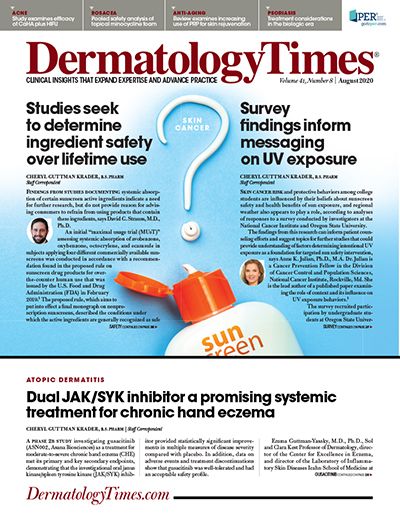- Case-Based Roundtable
- General Dermatology
- Eczema
- Chronic Hand Eczema
- Alopecia
- Aesthetics
- Vitiligo
- COVID-19
- Actinic Keratosis
- Precision Medicine and Biologics
- Rare Disease
- Wound Care
- Rosacea
- Psoriasis
- Psoriatic Arthritis
- Atopic Dermatitis
- Melasma
- NP and PA
- Skin Cancer
- Hidradenitis Suppurativa
- Drug Watch
- Pigmentary Disorders
- Acne
- Pediatric Dermatology
- Practice Management
- Prurigo Nodularis
- Buy-and-Bill
Publication
Article
Dermatology Times
Pilot study examines facial microbiome diversity
Author(s):
A study in twins highlights exacerbating factors for patients with rosacea and the importance of the microbiome.
Patients with rosacea show a less diverse facial skin microbiome, according to study results presented in an e-poster during the AAD VMX Virtual Meeting Experience 2020, June 12-14.1
Depending on the subtype, patients with rosacea can present with symptoms of flushing, redness, pimples, pustules, and dilated blood vessels typically located on the central face. Among factors associated with symptoms is a possible inflammatory reaction to the skin microbiome. Researchers highlighted some of these exacerbating factors and the importance of the microbiome in the treatment and management of rosacea patients.
“What we’ve learned over the last few years is that rosacea is so much more than just inflammation of the face, suggesting that there may be other types or more systemic inflammation,” says Justin W. Marson, M.D., department of medicine, University of California at Irvine, Orange, Calif., and head-author of the study. “Past studies have already associated the disease with inflammatory bowel disease, metabolic disorders, type 1 diabetes, dementia as well as mixed data on systemic cardiac events such as heart disease. There’s more than just inflammation in rosacea and what exactly drives that inflammation is becoming clearer.”
Dr. Marson and fellow colleagues recently conducted a study during the 2017 Twins Day Festival in which identical and fraternal twins with (n=88; average age 50 years) and without (n=48; average age 46 years) rosacea were surveyed on numerous parameters including history of rosacea as well as various environmental factors. Microbiome data was collected and analyzed for 16S sequences clustered into Operational Taxonomic Units (OTUs) using the UPARSE algorithm. Rosacea evaluation was made by a board-certified dermatologist, and the vast majority of participants with rosacea were assessed to have moderate to severe disease.
Results showed that individuals with rosacea are more likely to currently own pets, have a lower Fitzpatrick score, and consume more alcohol than their control counterparts. Researchers found that although individuals with rosacea demonstrated a decreased variation in facial cutaneous microbiome compared to control, there was no significant difference in bacterial load in the facial cutaneous microbiome or enteral microbiome between rosacea or their counterpart controls.
“We found that the amounts of bacteria did not really differ terribly much between the people with rosacea and the control population. However, it was the diversity and the variety of organisms that were found in the skin and to a lesser extent in the gut flora that was interesting,” Dr. Marson says.
Data showed that there was a three- to four-fold decrease in abundance of facial cutaneous bacterial genera Streptococcus, Corynebacterium, Actinomyces, Lactococcus, Veillonella, and Chloroplast in rosacea compared to control. In the gut microbiome, researchers found a significant reduction in abundance of Ruminococcaceae, and Blautia, and a six-fold increase in Prevotellaceae in rosacea compared to control.
“I think that these results can almost serve as a proxy for healthiness regarding the microbiome of the skin and gut. Although much work still needs to be done, this data could be used to potentially help us determine who might be more prone for inflammation. If potentially having the decreased diversity set the individual up for more inflammation, or vice versa where potentially organisms are lacking, maybe restoring the balance could decrease inflammation and improve rosacea symptoms,” Dr. Marson says.
At present, the genesis of rosacea symptoms remains unclear as to whether certain organisms are being missed, if there are certain organisms that perpetuate the inflammation in the skin, or if the inflammation itself leads to a decrease in the variety of organisms.
“Beyond an elusive probiotic pill to attempt to restore balance, one of the best thing rosacea patients can do is to practice good skin hygiene, regularly using sunscreen and moisturizer, and maintain a well-balanced diet. This way, patients could hopefully develop a healthy and even microbiome inside and outside of their body,” Dr. Marson says.
Disclosure:
Dr. Marson reports no relevant disclosures
Reference:
1. Marson JW, Mouser P, Berto S, Baldwin HE. Cutaneous and Enteral Dysbiosis: A Rosacea Pilot Study from the Twin’s Day Festival.
E-poster presented at AAD VMX Virtual Meeting Experience 2020 July 12-14.https://eposters.aad.org/posters/12762/12762.pdf







